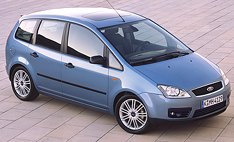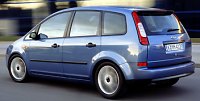|
 In
2003, Ford has lost its second place in worldwide sales chart to Toyota
and it is facing increasing financial troubles. In my view, the fall of
the Ford empire is mostly due to its short-sighted product strategy and
messy management. I take this one as an example. In 1997, Renault
created
a new compact MPV segment by launching Scenic. Many rival car makers
followed
immediately. But not Ford. When Ford started realizing the potential of
this segment, it greenlighted a project developing a Scenic-rival base
on the existing Focus platform. Normally, a program like this takes
around
2 years, which means the Focus MPV should make its debut in 2000. In
2003, Ford has lost its second place in worldwide sales chart to Toyota
and it is facing increasing financial troubles. In my view, the fall of
the Ford empire is mostly due to its short-sighted product strategy and
messy management. I take this one as an example. In 1997, Renault
created
a new compact MPV segment by launching Scenic. Many rival car makers
followed
immediately. But not Ford. When Ford started realizing the potential of
this segment, it greenlighted a project developing a Scenic-rival base
on the existing Focus platform. Normally, a program like this takes
around
2 years, which means the Focus MPV should make its debut in 2000.
However,
in the
middle of
the development, Ford saw Opel launched Zafira with an innovative
"Flexi-7"
seats. Ford was afraid that the 5-seat Focus MPV could not compete with
the new rival’s 7-seat design, thus eventually cancelled the project.
Instead,
it decided to build the MPV base on the next generation Focus platform
because it would be flexible enough to accept a longer body for 7
seats.
In this way, the launch date was delayed by 3 years and Ford lost
hundreds
of thousand units of sales.
More
ridiculously
is, when
the Focus MPV finally launched in late 2003, it was actually a
5-seater.
It won’t be available as a 7-seater in the future, said Ford, because
only
8% customers have more than 2 kids. This seems interesting when most of
the strongest rivals bet on the 7-seat trend, such as Opel Zafira,
Volkswagen
Touran, Renault Grand Scenic, Honda Stream and Toyota Avensis Verso.
The
truth is: Ford met some technical difficulties in enlarging the new
platform.
Opting not to spend extra investment and time to solve the problem, it
can only satisfy with a 5-seater.
So, that was
how
C-Max born.
The C-Max doesn’t break any rules of compact MPV, but it sets standard
in driver appeal, thanks to the new-Focus platform underneath. For a
starter,
the platform rides on the famous control-blade multi-link rear
suspensions,
offering superb absorption and tight body control simultaneously.
Refinement
is further improved by a sub-frame mounting the front struts
suspensions.
This reduces noise and harshness transmitted to the steering column as
well. The steering of the top 2.0TDCi model is assisted by
electro-hydraulic
system. It is light, precise and refined. Although not as communicative
as the hydraulic system of cheaper models, it feels more natural than
the
pure electric system used by many rivals.
The
suspension
setting is
typical European Ford - initially, the ride feels firm, but it damps
beautifully
on bumpy surfaces. Compare with the current Focus, the C-Max rides even
smoother and quieter. Compare with rival MPVs, the C-Max is more agile,
more resistant to body roll and understeer. It should please keen
drivers.
 The
choice of engine reflects European’s love affair of diesel - 2 diesels
and 1 petrol are offered. The highest performance engine is also a
diesel.
Thanks to a joint-venture agreement, PSA group supplies the C-Max with
its second-generation (1600 bar injection pressure) common-rail
direct-injection
variable-geometry turbocharged 16V 2.0-litre diesel. This is
undoubtedly
a good news, as PSA’s diesel engines are always refined. Its 136
horsepower
and 236 lbft of torque also enable sparkling performance for a MPV. A
slick
6-speed manual gearbox from Mondeo ST220 is mated with this engine. The
other engines are a 120hp 1.8-litre petrol and a 110hp 1.6TDCi turbo
diesel. The
choice of engine reflects European’s love affair of diesel - 2 diesels
and 1 petrol are offered. The highest performance engine is also a
diesel.
Thanks to a joint-venture agreement, PSA group supplies the C-Max with
its second-generation (1600 bar injection pressure) common-rail
direct-injection
variable-geometry turbocharged 16V 2.0-litre diesel. This is
undoubtedly
a good news, as PSA’s diesel engines are always refined. Its 136
horsepower
and 236 lbft of torque also enable sparkling performance for a MPV. A
slick
6-speed manual gearbox from Mondeo ST220 is mated with this engine. The
other engines are a 120hp 1.8-litre petrol and a 110hp 1.6TDCi turbo
diesel.
The C-Max
rides
on the same
wheelbase as its platform sharing sisters - Focus, Mazda 3 and Volvo
S40.
However, it is much wider and taller to give its occupants noticeably
more
space inside. Enter the cabin, you will be impressed by its elegant
design
and high-quality finish, and then the clever design of rear seats.
Because
of the lack of extra seats, the C-Max can make better use of the space
to serve the rear passengers. Its rear seats are split into 2
proper-sized
outer seats and a narrower middle seat. Backrest of the middle seat can
fold down to form a table. Like the recently-launched Opel Meriva and
Signum,
when the C-Max sits only 4 people, the middle rear seat can fold up and
back, allowing the outer seats to slide inwardly and diagonally
backward,
liberating 100mm more legroom and 60mm more shoulder room. Whether Ford
copied this idea from Opel or created by itself is unknown.
With
all seats in
place,
the C-Max holds up to 550 litres of luggage. To place larger goods, you
can lift the rear seats. However, if you want to put a mountain bike
into
it, the rear seats will need to be detached from the cabin, which is
not
an easy process. In contrast, Opel Zafira and Meriva offer a cleverer
solution:
their rear seats fold onto the floor and become part of a flat loading
area.
Ford C-Max is
currently the
most car-like compact MPV. It goes rapidly, it handles brilliantly and
rides well. On the negative side, it offers little versatility and
accommodation
over new generation hatchbacks. Inevitably, the border between cars and
MPVs will get fuzzier in the future. C-Max will not be alone crossing
this
border. One day this kind of car/MPVs might outsell conventional
hatchbacks,
who knows? |